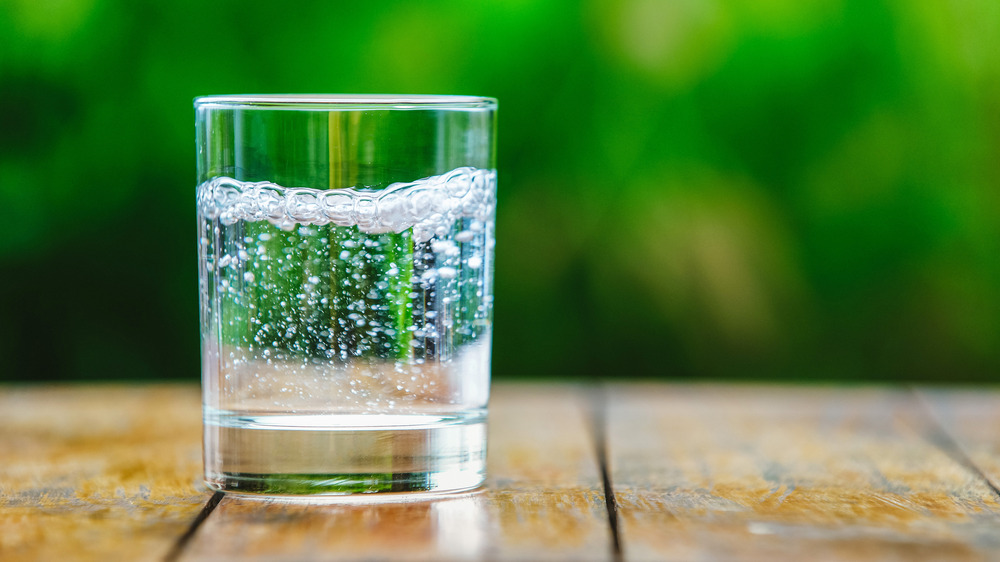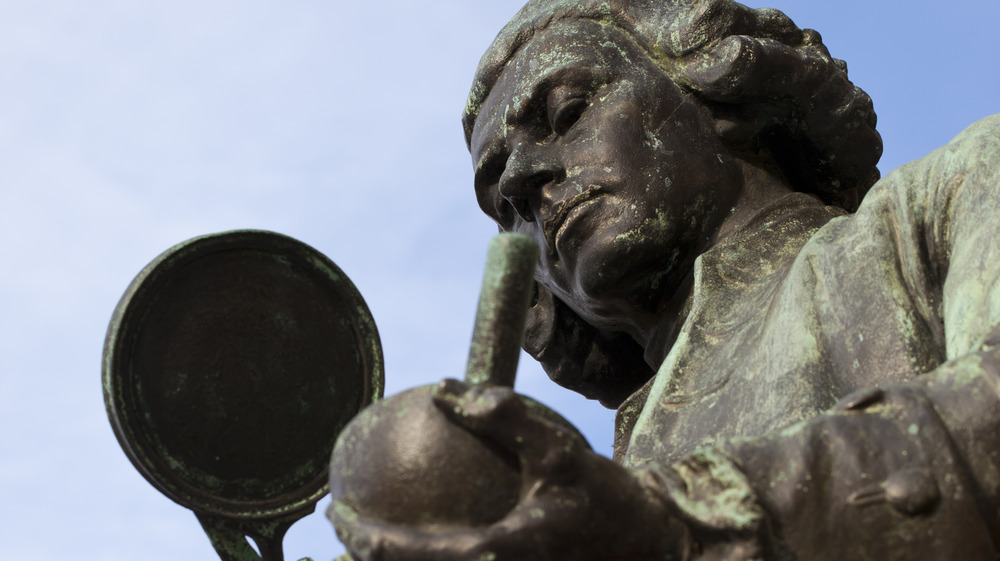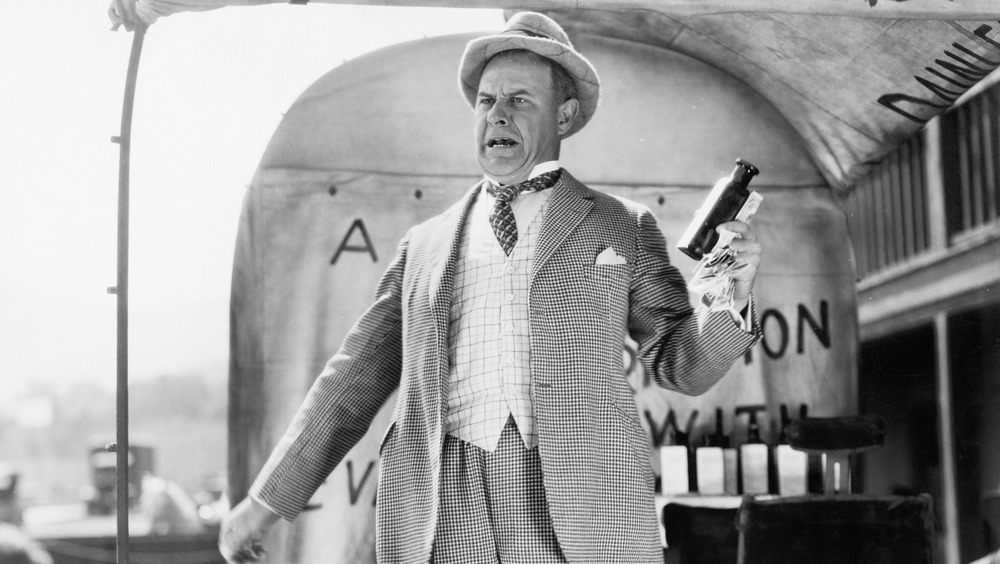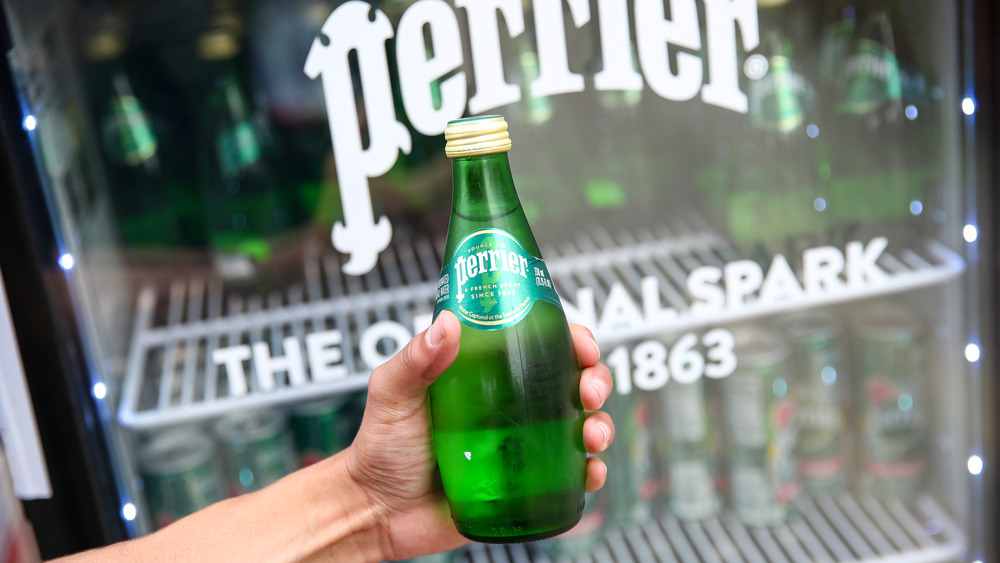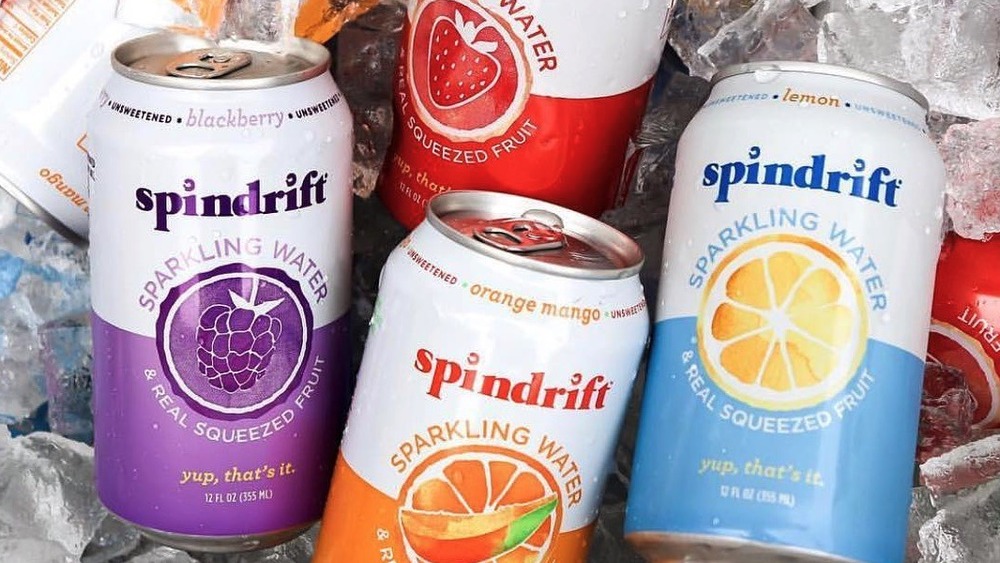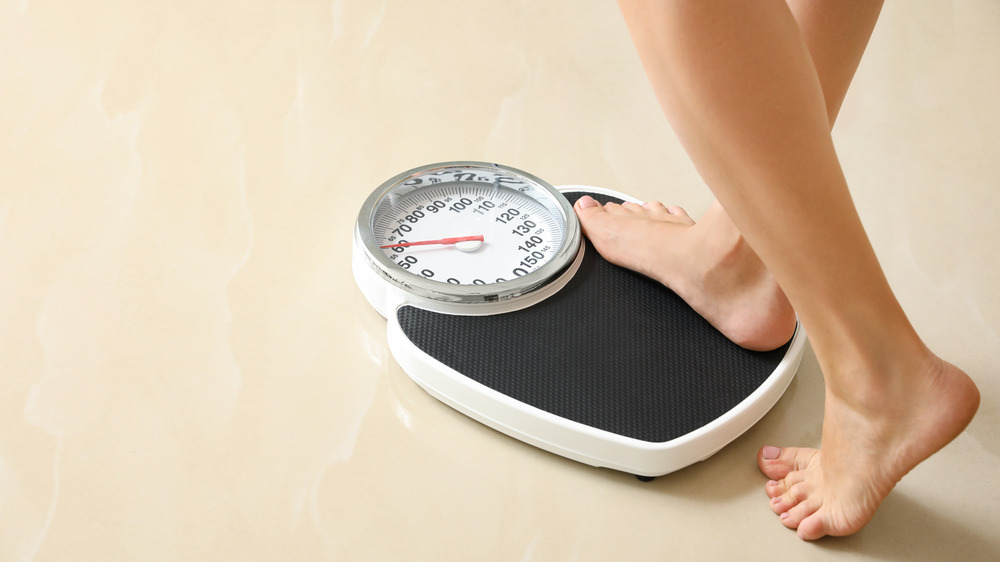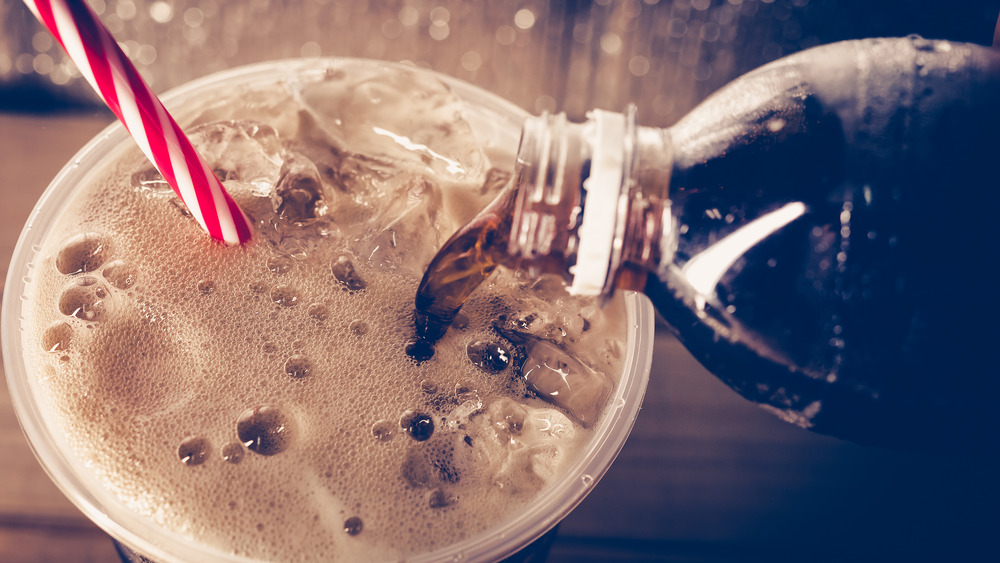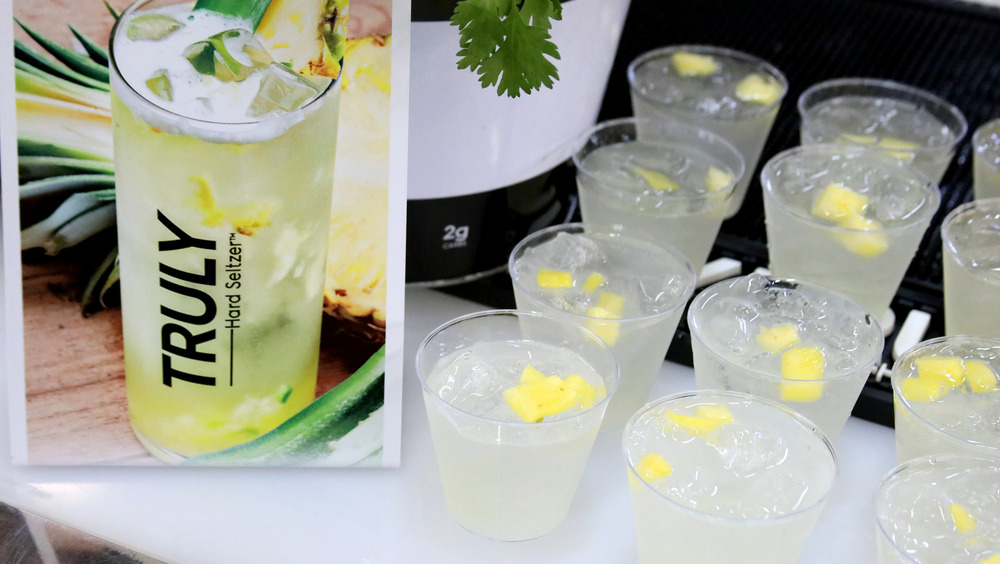The Untold Truth Of Sparkling Water
In case you hadn't noticed, sparkling water is having a serious moment recently. Or maybe saying having its movement would be more accurate because, while carbonated water is nothing new, its proliferation as a beverage of choice is a recent but surging phenomenon that's taken over foodie social media, backyard parties, and quite possibly your own kitchen. People all over the globe are ditching sugar-laden soda in favor of this far healthier alternative. Meanwhile, sparkling water brands are responding to consumer demand by offering an ever-expanding roster of new flavors and whole new products, from seltzers with caffeine, alcohol, CBD, and more.
From Bubly to Waterloo, to Canada Dry, to Polar, to Good & Gather, even on down to DIY sparkling water options like SodaStream, it can be difficult to tell which sparkling waters might best suit your palate. And with all the brands and product types out there, it's also hard to get to the bottom of things and get the facts about sparkling water.
Just dip a toe into the sparkling waters, and you'll encounter a plethora of questions. Is it really as safe of an alternative to soda as sparkling water proponents would have you believe? Is seltzer water here to stay, or is this just a seltzer bubble just waiting to burst, so to speak? And what's next for the sparkling water industry? To cut through the fizz, we did a deep dive into the carbonated topic. Here's everything you need to know about sparkling water.
Artificially carbonated water has been around for more than 250 years
Naturally occurring carbonated water, such as the type that's often created in mineral-rich environments, has of course been around for billions of years. Those sources, which can stem from mineral springs and in volcanic regions, have often been sought after for their supposedly medicinal properties.
Artificially carbonated water might not have been around for quite that long, but surprisingly it can be dated to more than two and a half centuries back in history. The very first manmade carbonation was achieved in the year 1767 by English scientist Joseph Priestley, according to SodaStream. He was inspired by the "airs" that came from a nearby brewery and was especially interested in the ones that went into the beer and made it bubbly (via McGill University).
Priestly was apparently more interested in the science of the matter and not as invested in the commercial potential of a sparkling beverage. It would take two more decades before someone jumped on that money train. In 1786, a Swiss gentleman began commercial sales of carbonated drinks. That man, Jacob Schweppes, remains a pretty familiar name today for fans of the sparkling water that still bears his name. By the 1830s, bottled carbonated drinks were for sale all over the world, and the forerunners of modern sodas were created as people began to add flavors and sweeteners to their bubbly drinks.
For many years, carbonated water was marketed as a health tonic
There are certain moderate health benefits to drinking carbonated water, such as those identified by a limited study reviewed by the Canadian Society of Intestinal Research. The study in question compared two groups of people with intestinal issues, one of which added a certain amount of carbonated water to their diets for a two-week period, the other of which did not. The review found that carbonated water appeared to have a beneficial effect, reducing symptoms of indigestion for the people who drank it. Meanwhile, the study group who consumed tap water saw no such effect.
These mild but welcome health improvements pale in comparison to the claims made over the salutary effects of bubbly waters in centuries past. According to an episode of "Distillations," a podcast released by the Science History Institute, some Ancient Romans believed sparkling mineral waters could help treat everything from skin disease to tumors to joint aches. Even many centuries later, in 18th Century Europe, "doctors would still tell their patients to drink mineral water, even instructing them on how many glasses to drink."
And by the 1800s, it was common to see bottled carbonated waters sold by pharmacists (as well as medical quacks) who would "set about trying to bring the health-giving benefits of spa waters to the city," according to Elemental.
There is a difference between club soda, seltzer, and sparkling mineral water
There are indeed differences between club soda, seltzer water, and sparkling mineral water, though some people might conclude that it's all similar enough to warrant passing over the fine details in favor of simply taking a sip. Yet, for others, those details can make a world of difference.
First, let's note that sparkling water and seltzer are essentially interchangeable terms, according to Eat This, Not That. Both simply refer to water with bubbles in it, generally via carbon dioxide. Some brands may also have added flavor or minerals to the mix, but that's more up to the manufacturer than to the nature of the drink.
Club soda, meanwhile, is seltzer water with added minerals that subtly enhance its taste, with common minerals used being potassium sulfate, sodium chloride (more commonly known as salt), disodium phosphate, and sodium bicarbonate, which you likely know as baking soda (via Healthline). Sparkling mineral water, on the other hand, is a naturally carbonated beverage with nothing added to the liquid by the human hand. Perrier is arguably the best-known example of this beverage type, which is little surprise given that it has been around since 1863.
Sparkling water is a quickly growing business today
According to Bill Creelman, the CEO and founder of sparkling water brand Spindrift, sales of this particular bubbly beverage rake in around $4 billion dollars annually in the United States alone. "To give you some context, soda sales are currently around $16 billion a year," Creelman says. This means that sales of sparkling water are "still relatively small, but growing very quickly. There's about 20% year over year growth."
And that growth is poised to become exponential. According to Creelman, "We're now projecting that, with traditional sparkling water, with spiked sparkling water, and with flavored sparkling waters [...] that it will be somewhere between $25 and maybe as high as $30 billion dollars by the year 2025. And at that scale, it's as big as energy drinks, it's bigger than soda, it really starts to be a big paradigm shift."
Creelman reports that his company, Spindrift, is currently the ninth fastest-growing sparkling water company in America and holds a 2% market share. Likewise, Beverage Industry reports that sparkling water is a pretty healthy subset of the bottled water industry overall, with an estimated $3.5 billion in sales from 2018 to 2019.
The growth of sparkling water is linked to health consciousness
In recent decades, millions of Americans have finally come around to embrace a healthier lifestyle than was common throughout much of the 20th century, a time that saw such immense increases in weight gain that it's been referred to as an "obesity epidemic," according to VoxEU. One of the unfortunate outcomes of the response to that so-called epidemic was a flourishing market for so-called "diet drinks."
Bill Creelman, CEO and founder of Spindrift, described himself as formerly addicted to Diet Coke. "Everyone was afraid of sugar 20 years ago," he told Mashed, "and that spawned 'diet' drinks and products, and we saw decades of all these weird diet products made with chemicals and aspartame and that sort of thing."
This isn't fearmongering, either. As it turns out, diet sodas can have a decidedly dark side, affecting not only your body's gut bacteria and glucose levels, but potentially even the way you taste and enjoy a beverage. Sparkling waters, with much smaller ingredient lists, are arguably more attractive to an increasingly health-conscious set of grocery store shoppers. Given that, as Statista reports, Americans are increasingly interested in changing their diets for the better — though still with some persistent consumption of fast foods thrown in the mix — this is no market to sneeze at.
There's one sparkling water health concern
Sparkling water is generally a healthy drink. Within reason, there is no reason not to consume as much of it as you wish. After all, sparkling waters as a class tend to contain very little sugar and few, if any calories. If you're being mindful about your waistline and overall state of health, that can definitely be a boon.
While we're at it, contrary to occasional misconception, seltzer water is not a diuretic and does not dehydrate you — quite the opposite. According to Healthline, sparkling water hydrates you every bit as well as regular fresh, still water. In fact, because many people are more apt to consume more sparkling water than still, it may even be more beneficial if only because people are more apt to drink it down.
But there is one potential unhealthy side effect of drinking sparkling water, according to The Atlantic. That would be, surprisingly enough, tooth decay. Because seltzers contain carbonic acid, they can present a danger to your tooth enamel. If you drink a ton of the stuff, the acidic water could potentially eat away at your tooth enamel and cause a host of dental problems. However, this damage can be easily offset by simply swishing with still water after drinking seltzer. Of course, you can also offset this issue with regular brushing, too. With proper oral care, there is no need for most people to eschew seltzers in the name of dental health.
Sparkling water is far superior to sugared soda in terms of your health
The relatively small concern that carbonated water may cause limited damage to tooth enamel pales to near transparency when you consider the deleterious health effects of most sugary sodas. Let's start with simple calorie counting. Whereas most carbonated waters contain zero net calories or perhaps 10 or 20 when there are a few ingredients like fruit extract are added to the mix, most full-sugar sodas have around 150 calories per 12-ounce serving, according to Medline Plus. Other sodas and most sugared energy drinks have many more than that.
What's worse, according to Healthline, is that whereas 150 to 200 calories of most foods would produce some sense of satiety, sugared sodas do not. This means that you are likely to consume their calories without even noticing you are doing so. The sugars in these sodas can cause an unhealthy imbalance in blood sugar levels, too, a grave concern for people with medical conditions like diabetes. Meanwhile, the excess sugars tend to turn to fat in the liver. And whereas carbonated water is hydrating, sodas have a diuretic effect, causing the body to get rid of fluids.
And then of course there is the fact that, as stated by Healthline, ingredients like the sugar and acid in soda are a "disaster for dental health." That's a far cry from the mild potential decay caused by carbonated water.
The sparkling water category is growing and changing rapidly
Whereas just a generation or so ago there were just a few brands even offering flavored seltzer waters, today the sparkling water category has expanded not only in volume but also in the diversity of products available on grocery store shelves. Alongside traditional sparkling water products that contain hints of lime or some healthful minerals, today you can find so-called "spiked seltzers" that contain alcohol offered by dozens of companies, with Truly and White Claw being some of the best known. Again, that arguably falls into line with the growing interest in relatively healthy food and drink. Compared to some heavier styles of beers, a 100-calorie White Claw could look pretty promising to a health-conscious consumer, according to the Chicago Tribune.
Alongside traditional and booze-infused seltzers, we can also now see a proliferation of caffeinated seltzers meant to help fuel people through their days. You might also find sparkling waters with ingredients intended to help aid relaxation and sleep, such as Pepsi's Driftwell, which is infused with L-theanine, an amino acid that may help promote relaxation.
Other new entrants to the category include brands offering hop-infused sparkling waters, such as Hoplark Hop Tea, which offers zero-calorie drinks that have a hop essence added to the mix. With this distinctive flavor, these drinks may replace beer for many consumers. However, it's worth remembering that, with their alcohol content, they're not the same as nonalcoholic beers, either.
